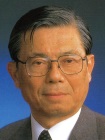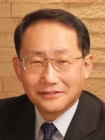Prof. Shiro Kira
Recollections of his unique water research surrounding the lung
A tribute by Prof. Nukiwa

Prof. Kira
"Research on water surrounding the lungs" is Prof. Kira's research concept that he often told to his group members. The function of the lung as a respiratory organ is generally gas exchange by air, in and out of the alveoli from the airway. That is, the lungs usually have a persuasive image of air ventilation. However, the lung is also a vascular organ composed of alveolar capillaries whose surface area is to be the entire tennis court. In other words, the lung is a "water" organ as well. The concept of "water surrounding the lungs'' includes lung water in health and diseases such as intra-alveolar vessels/extra-alveolar vessels, lung edema, lung injury, pleural effusion, pulmonary hypertension, and even IVC.
Prof. Kira graduated from the University of Tokyo School of Medicine in 1955 and majored in respiratory diseases after residential training. Around 1960s, the progress of cardiac surgery was spectacular and attracted young medical scientists, and it might be partly a reason why Prof. Kira focused on pulmonary circulation. He later noted that it was Prof. Michiyoshi Harasawa's review on pulmonary circulation in Japanese after he returned from US that invited Prof. Kira to pulmonary circulation. Prof Harasawa is of course well known as one of the APSR founders and was Prof. Kira's senior doctor in Tokyo University pulmonary group. The review was so impressive that it described pulmonary circulation such as hypoxic vasoconstriction, cor pulmonale, lung edema and pulmonary thromboembolism.
Prof. Kira studied at the New York State University in Buffalo in 1962 under the recommendation of Prof. Harasawa and studied in the laboratory of Prof. Simon Rodbard. His research there were on the pressure difference in the pulmonary blood in intra-alveolar/extra-alveolar vessels, pulmonary blood vessel capacity, and the relations of the bloodstream (Kira S, Rodbard S, Pulmonary vascular compliances and filtrations. Am Heart J. 1966 ;71(3):371-80., Rodbard S, Kira S, Mechanical forces and pulmonary vascular conductance. Am Heart J. 1966 ;72(4):498-508).
On returning to Japan in 1964, his work on pulmonary circulatory physiology was further developed (Kira S, Hukushima Y, Effect of negative-pressure inflation on pulmonary vascular flow. J Appl Physiol. 1968 ;25(1):42-7), and a new research on impedance plethysmography using pulmonary artery impedance by high-frequency current applied from the chest wall was started (Kira S, et al. Transthoracic electrical impedance variations associated with respiration. J Appl Physiol. 1971 ;30(6):820-6.).
After working as Associate Professor at the Juntendo University in 1972, he was appointed as Professor of Respiratory Medicine at the newly established Jichi Medical University in 1975, where he led both the research and the respiratory clinic. Prof. Kira conducted further clinical application of impedance plethysmography and started the respiratory application of ultrasonic equipment, non-invasive ECHO imaging, which was then introduced into the clinic, and revealed the relationship between central venous pressure (CVP) and collapsibility index through the IVC diameter measurement (Natori H, et al. Ultrasonographic evaluation of ventilatory effect on inferior vena caval configuration. Am Rev Respir Dis. 1979 ;120(2):421-7). On the other hand, research on lung injury as non-cardiogenic lung edema due to oleic acid was started with a canine model of unilateral lung injury. Using a unique enzyme activity of angiotensin converting enzyme (ACE) that locates on the alveolar capillary lumen, they reported that injury by oleic acid causes ACE elevation and progress of lung edema (Nukiwa T, et al. Responses of serum and lung angiotensin-converting enzyme activities in the early phase of pulmonary damage induced by oleic acid in dogs. Am Rev Respir Dis. 1982 ;126(6):1080-6.).
Prof. Kira moved to Tokyo as Professor at the Juntendo University in 1985, and further developed a technique for diagnosing respiratory diseases using ultrasound imaging. Using a novel MRI equipment his group showed a correlation between right ventricular hypertrophy index (RVWT/LVPWT) and mean pulmonary artery pressure (Saito H, et al. Evaluation of cor pulmonale on a modified short-axis section of the heart by magnetic resonance imaging. Am Rev Respir Dis. 1992 ;146(6): 1576-81.). In addition, as a new research direction that incorporates molecular biology from lung physiology, Prof. Kira launched a new research on pulmonary hypertension using model rats. The project was conducted by doctors back from the Cardiovascular Pulmonary Laboratory, University of Colorado, Denver, USA. Another new direction was based on molecular mutational analysis of α1-antitrypsin deficiency by doctors back from Pulmonary Branch, NHLBI, Bethesda, USA, and they reported a novel deficiency gene, Siiyama, in Japanese population (Seyama K, et al. Siiyama (serine 53 (TCC) to phenylalanine 53 (TTC)). A new alpha 1-antitrypsin-deficient variant with mutation on a predicted conserved residue of the serpin backbone. J Biol Chem. 1991 Jul 5;266(19):12627-32.).
At the Juntendo University, Prof. Kira made a major contribution to the spread of home oxygen therapy (HOT) in Japan as Principle Investigator of the Respiratory Failure, a national research project for intractable lung diseases in the Ministry of Health and Welfare. He served as Dean of the Medical Department of the Juntendo University in 1994.
Prof. Kira is very enthusiastic not only in basic respiratory research but also in clinical practice. He attended almost all thoracic surgery cases related to his clinical ward and joined inpatient autopsy examinations. In the clinical data conference for hospitalized cases, the logical step of clinical diagnosis was emphasized, and he always conducted the conference with sharp questions to the presented cases. Through such guidance and education, more than 10 medical professors have been born.
In the Japanese Respiratory Society (JRS), he worked as the director for more than 10 years and served as President of the Annual JRS Meeting in 1994. In APSR, he worked as Secretary General of the first meeting in Tokyo in 1988, the Editor in Chief of "Respirology", an official journal, in 1995, and served APSR President in 2000.

Prof. Nukiwa
Prepared by
Toshihiro Nukiwa, MD, PhD
Professor Emeritus, Tohoku University, Sendai Japan
Chair of the Board Directors, JRS in 2008-2010
President of the Congress of the Asian Pacific Society of Respirology in Yokohama in 2013
August 2019
Dr. Nukiwa first met Prof. Kira while he was at the residential training in 1977. He was impressed by Prof. Kira's comment on the case he presented and joined his group in Jichi Medical University. He was also interested in Prof. Kira's way of thinking as a physician scientist and the way to conceptualize the clinical phenomena. Although Prof. Kira works in physiology and Dr. Nukiwa works in biochemistry and molecular biology, Prof. Nukiwa is proud of being a molecular biologist who can understand VA/Q physiology because he was one of Prof. Kira's mentees.